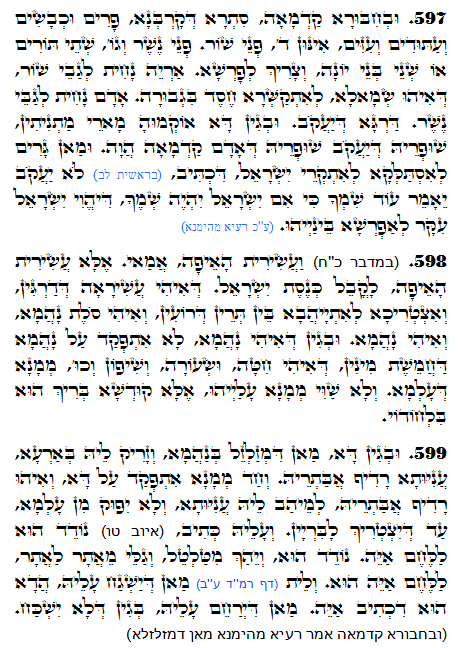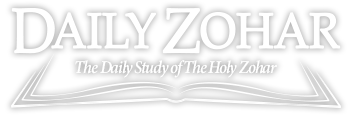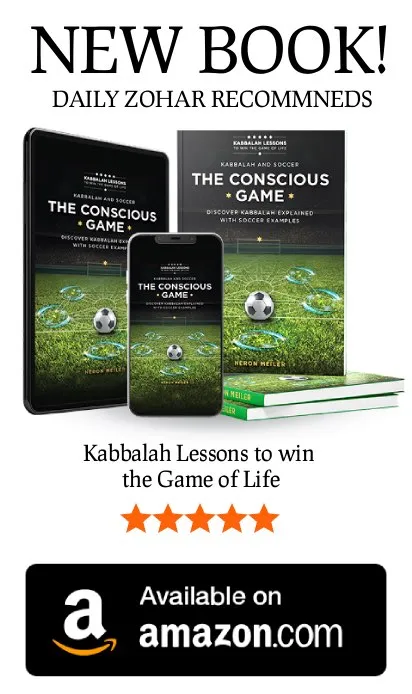Daily Zohar # 1869 – Pinchas – Holy bread
This study is a re-post from DZ 1284
Zohar Pinchas, Vol. 20 (English)/Vol 15 (Hebrew)

Hebrew translation:
598. וַעֲשִׂירִית הָאֵיפָה (במדבר כח), מַדּוּעַ? אֶלָּא עֲשִׂירִית הָאֵיפָה, כְּנֶגֶד כְּנֶסֶת יִשְׂרָאֵל, שֶׁהִיא הָעֲשִׂירִית שֶׁבַּמַּדְרֵגוֹת, וּצְרִיכָה לְהִנָּתֵן בֵּין שְׁתֵּי זְרוֹעוֹת, וְהִיא סֹלֶת הַלֶּחֶם, וְהִיא לֶחֶם. וּמִשּׁוּם שֶׁהִיא לֶחֶם, לֹא הֻפְקַד עַל לֶחֶם שֶׁל חֲמֵשֶׁת הַמִּינִים, שֶׁהֵם חִטָּה, וּשְׂעוֹרָה, וְשִׁיפוֹן וְכוּ’, מְמֻנֶּה שֶׁל הָעוֹלָם. וְלֹא שָׂם מְמֻנֶּה עֲלֵיהֶם, אֶלָּא הַקָּדוֹשׁ בָּרוּךְ הוּא לְבַדּוֹ.
599. וּמִשּׁוּם זֶה מִי שֶׁמְּזַלְזֵל בְּלֶחֶם וְזוֹרֵק אוֹתוֹ בָּאָרֶץ, עֲנִיּוּת רוֹדֶפֶת אַחֲרָיו. וּמְמֻנֶּה אֶחָד הֻפְקַד עַל זֶה, וְהוּא רוֹדֵף אַחֲרָיו לָתֵת לוֹ עֲנִיּוּת, וְלֹא יוֹצֵא מִן הָעוֹלָם עַד שֶׁיִּצְטָרֵךְ לַבְּרִיּוֹת. וְעָלָיו כָּתוּב, (איוב טו) נֹדֵד הוּא לַלֶּחֶם אַיֵּה. נֹדֵד הוּא, וְיֵלֵךְ מִטַּלְטֵל, וְגוֹלֶה מִמָּקוֹם לְמָקוֹם, לַלֶּחֶם אַיֵּה הוּא. וְאֵין מִי שֶׁיַּשְׁגִּיחַ עָלָיו. זֶהוּ שֶׁכָּתוּב אַיֵּה מִי שֶׁיְּרַחֵם עָלָיו, מִשּׁוּם שֶׁלֹּא יִמָּצֵא.
Pinchas 597-599
Numbers 28:5
“וַעֲשִׂירִית הָאֵיפָה סֹלֶת, לְמִנְחָה, בְּלוּלָה בְּשֶׁמֶן כָּתִית, רְבִיעִת הַהִין.”
“and the tenth part of an ephah (‘Baked’) of fine flour for a meal-offering, mingled with the fourth part of a hin of beaten oil.”
The tenth is for the nation of Israel, that is the aspect of the tenth level, Malchut. The flour is processed and baked to make bread. It is offered with two hands, Right for the Chessed and Left for Gevurah.
The bread is made from five species of חִטָּה, וּשְׂעוֹרָה, וְכֻסֶּמֶת, וְשִׁבֹּלֶת שׁוּעָל, וְשִׁיפוֹן
Wheat, barley, buckwheat, avena, and rye.
Jeremiah 2:3
“קֹדֶשׁ יִשְׂרָאֵל לַיהוָה, רֵאשִׁית תְּבוּאָתֹה”
“Israel is YHVH hallowed portion, His first-grain”
The original grass type (low connection to earth) that holds the grains needs to go through a process of several steps before it is ready for baking the bread. It is beaten to loosen up the hold of the elements that hide the desired grain. Then the grains are separated and ground into fine flour that is used to bake the bread.
Malchut has the greater desire for the Light of Chokmah and the bread for the offering is made with oil. It adds the aspect of Chokmah and expresses the great desire for the Light.
The Challah bread that we bake (or buy) for Shabbat and holidays has special spiritual value. The Zohar reveals that God is directly responsible and nourishes these grains. The leftovers should not be disposed as garbage. It should be consumed or fed to birds, animals, fish etc. with the consciousness of “נותן לחם לכל בשר”,”Gives bread to all flesh”. We recite these words in ‘Birkat Hamazon’, the blessing that we do after the meals.
Disposing the blessed bread as garbage is like wasting energy of the light. The Zohar tells us that this brings lack of sustenance and poorness to the person who does that.
It is good to make blessings using two breads for right and left as explained above. Using twelve Challahs is on a higher level and it can be done when there are 10 or more people sharing the same meal.
{||}

 Previous: Pinchas
Previous: Pinchas

